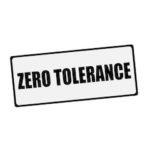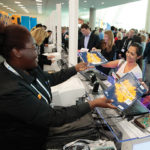
It was a familiar scene at Chicago’s McCormick Place this past May, when more than 61,000 registrants from all 50 states and more than 100 countries gathered for the National Restaurant Association (NRA) Restaurant HotelMotel Show and the International Wine, Spirits & Beer Event, a concurrent show for beverage alcohol buyers. That’s because NRA’s 93-year-old annual trade show – the restaurant industry’s premier showcase for products, equipment, and trends, and the biggest single meeting for restaurant, food-service, and lodging professionals in the United States – has called Chicago home for the past 63 consecutive years. When you layer on top of that the fact that it’s been held during the same week for the past 31 years, you get why one longtime exhibitor calls the show “my ‘Groundhog Day’” – a reference to the 1993 movie in which Bill Murray’s character is destined to live the same day over and over.
Planning and hosting a show of this size is no easy feat for any organization, but keeping things fresh enough to prevent that déjà vu feeling – while preserving what’s familiar, tried, and true – is even more challenging. “It’s a fine line,” said Mary Pat Heftman, NRA’s executive vice president, convention, who heads a 25-person team that works year-round on the planning, production, and promotion of the show. “You have to be able to recognize what works and what needs to change.”
The NRA Show is one of the largest trade shows in the United States (currently ranked number 34 by the Trade Show News Network), “but a lot of the lessons can be applied to a show that’s only 100 square feet, [and has] 300 exhibitors and 12,000 attendees,” said John Patronski, executive vice president for industry development at Global Experience Specialists (GES), NRA’s longtime general services provider. “If you separate out the size and the specific industry, all show organizers go through a similar challenge: How do you reinvent a show and generate excitement?”
Convene walked the exhibit floor at the 2012 NRA Show, spoke with show veterans and first-timers, and conducted interviews with NRA staff members before and after the show to gain insight into how – and how well – the association handles that challenge.
Scheduling Conflict
The show that always is almost wasn’t this year. In June 2011, it was announced that Chicago would host the NATO Summit the weekend of May 18, 2012 – the same weekend as the NRA Show. Recognizing the massive security and transportation headaches that would accompany the arrival of so many heads of state – not to mention the competition for prime hotels and restaurants – NRA executives began exploring the possibility of moving the show to a different location. “We performed a risk-reward analysis to see what space could fit our needs,” Heftman said. “Our industry really enjoys Chicago, but we knew they would want to experience it in the way they traditionally have, in terms of convenience and enjoyability.”
And so with that – and the incentive of a city-provided financial package that media sources estimated at $2 million – NRA announced its show would stay in Chicago, but move up by two weeks, to May 5–8. The association then unleashed a torrent of advertising and marketing communications to promote the new dates. The message was well received. Several weeks prior to the show, NRA announced that the 540,000-square-foot show floor – nearly six square miles of exhibit space – was completely sold out. Close to 2,000 companies, including 500 new exhibitors, had filled every available inch of McCormick Place and were ready for the show, new dates and all.
Making Its Case
Changing the show weekend for the first time in 30 years was a significant shake-up, but Heftman and her team had more up their sleeves, including a rebranding effort and a new marketing campaign. “We update our on-site look every three years, [but] this was much more than a redesign,” Heftman said. “We developed an entirely new campaign concept and messaging, as well as a look and feel.”
The new look was intended to energize attendees after a couple of hard years. According to consumer market research company NPD Group, the number of U.S. restaurant visits fell by more than two billion between 2008 and 2011. But now, after a slight rebound last year and a positive – if not ebullient – forecast for 2012, the industry is feeling a bit more sure-footed. According to NRA’s own 2012 Restaurant Industry Forecast, total restaurant sales are expected to reach a record high of $632 billion this year, a 3.5-percent increase over 2011. And according to NRA’s April 2012 performance index, restaurant operators’ outlook for capital spending is at its highest level since summer 2007.
“There’s a pent-up demand and excitement now to get back out and see what’s new,” Heftman said. “People are ready to not just stay the course, but step it up. They’re making commitments to capital spending, and they’re excited to get together again.”
NRA wanted to be ready for that. So, starting more than a year out, the association began exploring new branding and marketing paths for the show. Focus groups helped organizers capture attendees’ perceptions of the show, and they used that insight to develop a new theme and creative concept for 2012: “Only here.” “The ‘Only here’ campaign is based on the idea that there are certain events, interactions, and learnings – both planned and serendipitous – that happen directly as a result of 61,000-plus industry professionals coming together in a single location,” Heftman said. “The only way to experience these things or to take part in them is to attend NRA Show.”
The new campaign seems to have tapped the right emotion: Post-show numbers showed overall attendance was up 6% from 2011.
Easier Navigation
As part of the 2012 makeover, the show floor was redesigned, resulting in 5 percent more square footage than in 2011. It was the first redesign for the show’s South Hall since 1997 and the first for the North Hall since the late ‘80s. “Not only was the attendee experiencing a new vibe as they entered McCormick Place,” Patronski said, “but they saw different companies in different locations, some with new exhibit designs and layouts, creating a new and different feel for the show. If the floor had been exactly the same as past years, it would have been just the same old floor, and I think it would have been a letdown.”
The floor redesign was both creative and strategic, Heftman said. For example, event spaces and stages were relocated to less-trafficked areas to direct more attendees to sections that didn’t get as much foot traffic in the past. “It’s all about driving value for exhibitors,” Heftman said, “and increasing the experience for attendees.”
The new design also featured an expanded number of “pavilions,” which grouped like exhibitors together. The pavilions provided a centralized showcase for niche products and solutions, and brought a sense of cohesion to the mammoth floor. In the Organic and Natural Pavilion, companies promoted and provided samples of a variety of vegan, gluten-free, dairy-free, organic, and fair-trade products. And the new Healthier Kids Fare Pavilion featured companies that can help restaurants incorporate more healthy choices into children’s meals.
“The show size was bigger this year, but the buzz on the floor was very exciting and much more positive than prior years,” Patronski said. “The show looked alive and was vibrant with new ideas and new products.”
Tech Is King
In the North Hall, the bustle of the Technology Pavilion reflected the growing influence of social-media, digital, and mobile technology on the industry. Vendors of digital scheduling systems, point-of-sale systems, digital menus, and e-everything vied for attendees’ attention in the crowded aisles. PeopleMatter, a Charleston, S.C.-based company that sells a paperless human-resources platform, commanded on of the larger booths and featured a swarm of employees in t-shirts emblazoned with the slogan “Paper is so 2011.”
OpenTable, the San Francisco-based online and mobile reservation-management system, is an NRA Show veteran (by technology-company standards), having exhibited for the past seven years. Brandon Bidlack, OpenTable senior director of restaurant marketing, said he’s seen the Technology Pavilion evolve in both size and focus. “In the early days, you’d see companies like ours alongside a new kind of toilet. We were all lumped together and it was a little bit all over the place,” he said. “Now, the whole industry is taking a more sophisticated approach to technology, and you see a lot more focus on it at the show.”
In addition to the increased number of exhibitors, 11 of the show’s 70 education sessions focused on technology. Because the Technology Pavilion this year included education space, as well as tables and chairs for networking, sessions were held right on the show floor – integrating education into the show experience more effectively. Patronski said: “It’s all about engaging the attendee.”
Vendors used technology to engage attendees in both fun and strategic ways. At the massive, 3,500-square-foot booth for Hobart–An ITW Food Equipment Group Company, mounted iPads and a new show app allowed customers to print spec sheets on demand. “It’s putting information right at the customers’ fingertips,” explained Joyce Grooms, Hobart’s manager of trade marketing. “It’s all customized, so they print only what they need, and we provide a more personalized experience.”
At Louisiana-based Community Coffee’s booth, employees offered attendees an iPad-based coffee and tea personality quiz. “This is our first show,” said Blair Broussard, marketing and communications manager, “and we thought it was a fun way to introduce ourselves to people.”
Like It, Tweet It, Share It
NRA itself relied heavily on technology to interact with attendees. A show app eliminated the need for bulky program guides and maps; and for the second year, the show ran NRA Show Daily Deals, similar to the online daily deals offered by Groupon and Living Social. For several days leading up to the show and every day during the show, registrants received an email promoting a deeply discounted Daily Deal on equipment, services, or technology offered by an exhibitor. Each Daily Deal represented a savings of 50 percent or greater; by the end of the show, 225 had been purchased.
Social media is an increasingly powerful influence within the restaurant industry – ask any restaurateur about the power of Yelp – and if attendees didn’t already get that, NRA made it hard to miss: A large monitor in the South Hall displayed a live Twitter feed of all show chatter (see it at #NRAShow). NRA staff was also busy posting on Facebook and the NRA Show blog, and tweeting throughout the event.
But no matter how many unique experiences, social events, and networking opportunities a show offers, it won’t get people to come back the following year if it doesn’t translate into sales. Against the quiet back wall of the North Hall – where it seemed attendees only ended up if they missed the turn into the Technology Pavilion – Chauncey Blaisdell manned the small JobApp Network booth. “We were late registering,” he said, gesturing to his less-than-ideal location, “but you have to start somewhere.” Blaisdell said the NRA Show had provided some good networking opportunities for first-time exhibitors, but he wasn’t yet sure if the event was a good fit, or if JobApp Network might be better suited to smaller, more focused shows, such as a franchise expo.
Back in the South Hall, in a prime, high-visibility location, sat the Carbon’s Golden Malted food truck, serving fresh, hot Belgian waffles. This year marked the company’s 54th consecutive NRA Show; coming back each year is a bit like old home week, said Tim Howard, customer service and distribution manager for the pancake- and waffle-mix company. “We have a long history with the show,” he said. “This is how we grew our company in the early days.”
Not only does the show give Carbon’s an opportunity to thank its longtime customers in person, Howard said, but it’s also the best way to generate new leads. By day two, he had already reserved the same booth space for the 2013 NRA Show. “How much easier could it be than to come to the NRA Show, where people from all over the world come looking for ideas?” Howard asked. “It’s a lot easier than going out and knocking on doors. And that’s why it’s so important to us.”
Changes the National Restaurant Association made to the 2012 NRA Show included:
- New creative concept and marketing campaign – “Only here.”
- Redesigned exhibit floor.
- New specialty pavilions for like exhibitors and niche products.
- New Operator Innovator Awards, with winners announced at an after-show party.
- New evening events – both large parties and exclusive, small-group dining experiences.
- More celebrity-chef appearances and book signings
- Expanded International Wine, Spirits & Beer Event, with total number of exhibiting companies up 40 percent over 2011.
- Increased social-media presence and tools.
Even though the NRA Show is the restaurant industry’s biggest trade show, you can’t assume people will come for that reason alone, said NRA’s Mary Pat Heftman. “We believe in a strategy that provides as many reasons as possible to say, ‘Yes, I will register, book a flight and hotel, spend time [away from] my business.’”
To that end, NRA added more networking events this year, plus new social events and after-show parties. “It’s all in the combination of providing the attendees and exhibitors with the very best options for networking, seeing/sampling products, entertainment, and a destination that will trigger them to not only attend, but stay engaged with the brand,” Heftman said.
A walk through the show floor at McCormick Place established that exhibitors weren’t passively displaying their products or services, but were looking for similar levels of engagement. “The key is to not just show up, but do something to create a buzz,” said Scott DeShetler, director of marketing for Ice-O-Matic, whose strategy for the 2012 show was a guerrilla marketing campaign that targeted show-goers at hotels and shuttle stops. Marketing staff carried placards and passed out pins with political-style slogans, such as “Demand More Ice for the Price” and “Just Say Yes to Productivity.”
The guerrilla campaign was the kick-off to the company’s new advertising campaign, “The Ice Cold Truth,” and Ice-O-Matic invited attendees to “Join the Movement” for campaign updates and product information. “We’re number four in an industry of four, so we need to approach things a little differently,” DeShetler said. “Our goal was to create a buzz, but also generate some serious leads.”
Another exhibitor looking to stand out was uniform and culinary apparel company Chef Works. Rather than displaying its apparel on mannequins, Chef Works produced an in-booth fashion show, complete with a glossy white runway, DJ, thumping music, emcee, and professional models. “You have to have an edge,” said Marcee Katz-Coons, vice president of national accounts. “This year, everyone’s talking about the fashion show. It’s hard not to notice us.”
While Chef Works provided a New York City–style fashion-runway experience, Community Coffee invited attendees to head south. The Louisiana-based company’s tagline is “the genuine flavor of New Orleans,” and its booth delivered on that promise by recreating a New Orleans street corner, complete with faux cobblestone floor, streetlights, and classic New Orleans streetcar. It wasn’t named Desire – but attendees seemed to get the picture.
More Resources
To learn more about the National Restaurant Association Show, visit restaurant.org/show.



